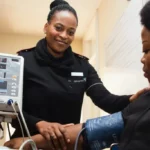Sexually Transmitted Diseases (STDs) or Infections (STIs) are serious health issues impacting many individuals. Understanding STDs is crucial for protecting your sexual health. As the name suggests, they primarily spread through sexual contact (vaginal, oral, anal) via bodily fluids like blood, semen, and vaginal fluids. Non-sexual transmission is also possible (e.g., mother-to-child, shared needles, contaminated blood).
A key challenge with STDs is that they often show no signs or symptoms (asymptomatic), yet can still be transmitted. However, sometimes symptoms do appear. Recognizing these potential signs of STDs is vital because they indicate you should seek an STD test promptly. Early diagnosis through an STD test leads to timely treatment and prevents further spread.
10 Potential STD Symptoms That Warrant an STD Test
If you experience any of the following, getting an STD test is highly recommended:
1. Unusual Rash or Bumps
What to look for: Small, possibly reddish-brown bumps or a rash appearing anywhere on the body, including genitals, rectum, mouth, palms, or soles of the feet.
Possible STDs: Syphilis, Herpes, HIV-related rash.
Action: If you notice such a rash, schedule an STD test.
2. Open Sores or Ulcers
What to look for: Painful or painless open sores (ulcers) on, near, or inside the genital or anal area, or mouth. Can cause pain during urination or general tenderness.
Possible STDs: Herpes, Syphilis, Chancroid.
Action: Any unexplained sores in these areas require medical evaluation and an appropriate STD test.
3. Pain or Burning During Urination
What to look for: A stinging or burning sensation when you pee.
Possible STDs: Chlamydia, Gonorrhea, Trichomoniasis, Herpes. (Note: Also a symptom of UTIs).
Action: Don’t ignore painful urination; get checked and request an STD test alongside a UTI check if appropriate.
4. Unusual Discharge or Swelling (Male Genitals)
What to look for: Discharge from the penis that is watery, cloudy (pus-like), or bloody. Swelling of the scrotum or testicles.
Possible STDs: Gonorrhea, Chlamydia, Trichomoniasis, less commonly Syphilis or Herpes.
Action: Penile discharge or unusual swelling needs assessment and likely an STD test.
5. Abnormal Vaginal Discharge or Bleeding
What to look for: Vaginal discharge that has an unusual color (yellow, green, grey), strong foul odor, or different consistency. Bleeding between periods or after sex.
Possible STDs: Gonorrhea, Chlamydia, Trichomoniasis, Bacterial Vaginosis (though not always sexually transmitted, often included in screening).
Action: Changes in discharge or abnormal bleeding warrant a check-up and potential STI test.
6. Genital or Anal Itching
What to look for: Persistent itching in, on, or around the vagina, penis, inner thighs, or anus/rectum.
Possible STDs: Chlamydia, Gonorrhea, Trichomoniasis, Herpes, Genital Warts (HPV), Pubic Lice, Scabies.
Action: Persistent genital or anal itching is a clear signal to get an STD test.
7. Lower Abdominal or Pelvic Pain
What to look for: A new, unexplained pain originating in the lower abdomen or pelvic area – could be dull, cramping, or intense. Sometimes pain below the right ribs (liver area) can occur with Hepatitis.
Possible STDs: Chlamydia or Gonorrhea (especially if progressed to Pelvic Inflammatory Disease – PID in women), Trichomoniasis, Hepatitis.
Action: Unexplained pelvic or lower abdominal pain should be evaluated by a doctor, including consideration for an STD test.
8. Fever or Flu-like Symptoms
What to look for: General feelings of being unwell, including fever, fatigue, nausea, vomiting, headache, or muscle aches, especially if occurring after potential exposure.
Possible STDs: Acute HIV infection, Hepatitis A/B/C, Syphilis, Herpes.
Action: While common for many illnesses, if these symptoms follow potential STD exposure, an STD test is advisable.
9. Swollen Lymph Nodes
What to look for: Tender, swollen glands in the neck, under the chin, armpits, or groin area. This indicates your body is fighting an infection.
Possible STDs: HIV, Syphilis, Herpes, Gonorrhea, Chlamydia, Lymphogranuloma Venereum (LGV).
Action: Swollen lymph nodes, particularly in the groin, alongside other potential symptoms, should prompt consideration for an STD test.
10. Diarrhea or Painful Bowel Movements
What to look for: Persistent diarrhea or pain during bowel movements, sometimes related to infections affecting the rectum.
Possible STDs: Gonorrhea, Chlamydia, Shigella, Giardia (can be sexually transmitted), HIV-related infections, Herpes.
Action: If these symptoms occur, especially after potential anal exposure, discuss the need for an STD test with your doctor.
Regular Screening is Key
Crucially, remember that many STDs cause no symptoms at all, especially in the early stages. Relying solely on symptom spotting is risky. Anyone who is sexually active can potentially contract an STD. Factors like unprotected sex, multiple partners, or sharing needles increase the risk.
Therefore, even without symptoms, regular screening is essential. It’s generally recommended to get an STD test at least once a year if you are sexually active, or more frequently depending on your risk factors.
Concerned About Symptoms or Need Routine Screening?
If any of these symptoms sound familiar, or if it’s time for your regular check, getting tested is straightforward. Worried about privacy or clinic visits? Healthtracka offers discreet, confidential at-home STD test solutions like the Lemon Kit.
- Collect Samples at Home: Receive a kit and collect your own blood, urine, and/or swab samples privately.
- Discreet Pickup & Delivery: We pick up your sample and deliver secure digital results quickly.
- Comprehensive Screening: Test for common STIs.
- Doctor Consultation: Discuss results and next steps with a doctor.
Prioritize your sexual health. If you have symptoms or need screening, book your confidential STD test with Healthtracka today.




